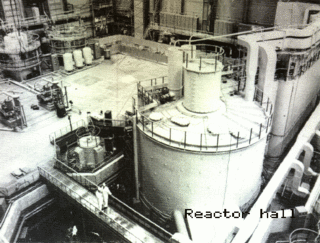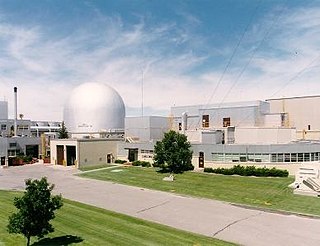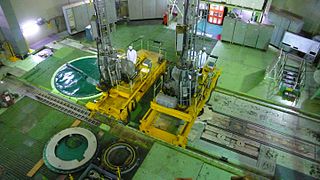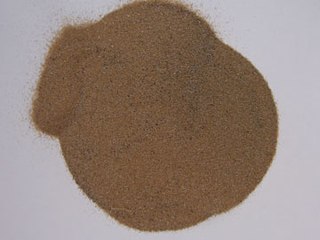
A nuclear reactor is a device used to initiate and control a fission nuclear chain reaction or nuclear fusion reactions. Nuclear reactors are used at nuclear power plants for electricity generation and in nuclear marine propulsion. Heat from nuclear fission is passed to a working fluid, which in turn runs through steam turbines. These either drive a ship's propellers or turn electrical generators' shafts. Nuclear generated steam in principle can be used for industrial process heat or for district heating. Some reactors are used to produce isotopes for medical and industrial use, or for production of weapons-grade plutonium. As of 2022, the International Atomic Energy Agency reports there are 422 nuclear power reactors and 223 nuclear research reactors in operation around the world.

A breeder reactor is a nuclear reactor that generates more fissile material than it consumes. These reactors can be fueled with more-commonly available isotopes of uranium and thorium, such as uranium-238 and thorium-232, as opposed to the rare uranium-235 which is used in conventional reactors. These materials are called fertile materials since they can be bred into fuel by these breeder reactors.

Phénix was a small-scale prototype fast breeder reactor, located at the Marcoule nuclear site, near Orange, France. It was a pool-type liquid-metal fast breeder reactor cooled with liquid sodium. It generated 590 MW of thermal power, and had a breeding ratio of 1.16, but normally had to be stopped for refueling operations every two months. Phénix continued operating after the closure of the subsequent full-scale prototype Superphénix in 1997. After 2004, its main use was investigation of transmutation of nuclear waste while also generating some electricity. Phénix was shut down in 2009.

A fast-neutron reactor (FNR) or fast-spectrum reactor or simply a fast reactor is a category of nuclear reactor in which the fission chain reaction is sustained by fast neutrons, as opposed to slow thermal neutrons used in thermal-neutron reactors. Such a fast reactor needs no neutron moderator, but requires fuel that is relatively rich in fissile material when compared to that required for a thermal-neutron reactor. Around 20 land based fast reactors have been built, accumulating over 400 reactor years of operation globally. The largest of this was the Superphénix Sodium cooled fast reactor in France that was designed to deliver 1,242 MWe. Fast reactors have been intensely studied since the 1950s, as they provide certain advantages over the existing fleet of water cooled and water moderated reactors. These are:

The integral fast reactor is a design for a nuclear reactor using fast neutrons and no neutron moderator. IFR would breed more fuel and is distinguished by a nuclear fuel cycle that uses reprocessing via electrorefining at the reactor site.

The Bhabha Atomic Research Centre (BARC) is India's premier nuclear research facility, headquartered in Trombay, Mumbai, Maharashtra, India. It was founded by Homi Jehangir Bhabha as the Atomic Energy Establishment, Trombay (AEET) in January 1954 as a multidisciplinary research program essential for India's nuclear program. It operates under the Department of Atomic Energy (DAE), which is directly overseen by the Prime Minister of India.

Indira Gandhi Centre for Atomic Research (IGCAR) is one of India's premier nuclear research centres. It is the second largest establishment of the Department of Atomic Energy (DAE), next to Bhabha Atomic Research Centre (BARC), located at Kalpakkam, 80 km south of Chennai, India. It was established in 1971 as an exclusive centre dedicated to the pursuit of fast reactor science and technology, due to the vision of Vikram Sarabhai. Originally, it was called Reactor Research Centre (RRC). It was renamed to Indira Gandhi Centre for Atomic Research (IGCAR) by the then Prime Minister of India Rajiv Gandhi in December 1985. The centre is engaged in broad-based multidisciplinary programme of scientific research and advanced engineering directed towards the development of fast breeder reactor technology in India.
Generation IVreactors are nuclear reactor design technologies that are envisioned as successors of generation III reactors. The Generation IV International Forum (GIF) – an international organization that coordinates the development of generation IV reactors – specifically selected six reactor technologies as candidates for generation IV reactors. The designs target improved safety, sustainability, efficiency, and cost. The World Nuclear Association in 2015 suggested that some might enter commercial operation before 2030.

A sodium-cooled fast reactor is a fast neutron reactor cooled by liquid sodium.

Madras Atomic Power Station (MAPS) located at Kalpakkam about 80 kilometres (50 mi) south of Chennai, India, is a comprehensive nuclear power production, fuel reprocessing, and waste treatment facility that includes plutonium fuel fabrication for fast breeder reactors (FBRs). It is also India's first fully indigenously constructed nuclear power station, with two units each generating 220 MW of electricity. The first and second units of the station went critical in 1983 and 1985, respectively. The station has reactors housed in a reactor building with double shell containment improving protection also in the case of a loss-of-coolant accident. An Interim Storage Facility (ISF) is also located in Kalpakkam.
The advanced heavy-water reactor (AHWR) or AHWR-300 is the latest Indian design for a next-generation nuclear reactor that burns thorium in its fuel core. It is slated to form the third stage in India's three-stage fuel-cycle plan. This phase of the fuel cycle plan was supposed to be built starting with a 300 MWe prototype in 2016.

The Fast Breeder Test Reactor (FBTR) is a breeder reactor located at Kalpakkam, Tamil Nadu, India. The Indira Gandhi Center for Atomic Research (IGCAR) and Bhabha Atomic Research Centre (BARC) jointly designed, constructed, and operate the reactor.

The liquid fluoride thorium reactor is a type of molten salt reactor. LFTRs use the thorium fuel cycle with a fluoride-based molten (liquid) salt for fuel. In a typical design, the liquid is pumped between a critical core and an external heat exchanger where the heat is transferred to a nonradioactive secondary salt. The secondary salt then transfers its heat to a steam turbine or closed-cycle gas turbine.

India's three-stage nuclear power programme was formulated by Homi Bhabha, the well-known physicist, in the 1950s to secure the country's long term energy independence, through the use of uranium and thorium reserves found in the monazite sands of coastal regions of South India. The ultimate focus of the programme is on enabling the thorium reserves of India to be utilised in meeting the country's energy requirements. Thorium is particularly attractive for India, as India has only around 1–2% of the global uranium reserves, but one of the largest shares of global thorium reserves at about 25% of the world's known thorium reserves. However, thorium is more difficult to use than uranium as a fuel because it requires breeding, and global uranium prices remain low enough that breeding is not cost effective.
Shivram Baburao Bhoje is a distinguished Indian nuclear scientist who worked in the field of fast-breeder nuclear reactor technology for forty years in the design, construction, operation, and research and development. Indian government has honoured him with Padma Shri in 2003, the fourth highest civilian award in India, for his distinguished service to science and engineering fields.
The BN-800 reactor is a sodium-cooled fast breeder reactor, built at the Beloyarsk Nuclear Power Station, in Zarechny, Sverdlovsk Oblast, Russia. The reactor is designed to generate 880 MW of electrical power. The plant was considered part of the weapons-grade Plutonium Management and Disposition Agreement signed between the United States and Russia. The reactor is part of the final step for a plutonium-burner core The plant reached its full power production in August 2016. According to Russian business journal Kommersant, the BN-800 project cost 140.6 billion rubles.

The BN-1200 reactor is a sodium-cooled fast breeder reactor project, under development by OKBM Afrikantov in Zarechny, Russia. The BN-1200 is based on the earlier BN-600 and especially BN-800, with which it shares a number of features. The reactor's name comes from its electrical output, nominally 1220 MWe.
The Fast Breeder Reactor-600 (FBR-600) or Indian Fast Breeder Reactor (IFBR) or Commercial Fast Breeder Reactor (CFBR) is a 600-MWe fast breeder nuclear reactor design presently being designed as part of India's three-stage nuclear power programme to commercialise the Prototype Fast Breeder Reactor built at Kalpakkam. The Indira Gandhi Centre for Atomic Research (IGCAR) is responsible for the design of this reactor as a successor for Prototype Fast Breeder Reactor (PFBR). The 1st twin unit would come up within the BHAVINI premises at Madras Atomic Power Station at Kalpakkam, close to the PFBR site itself.
The BREST reactor is a Russian conceptual design for a lead-cooled fast reactor based on a generation IV reactor. Two designs are planned, the BREST-300 and the BREST-1200. The main characteristics of the BREST reactor are passive safety and a closed fuel cycle.

The IPHWR is a class of Indian pressurized heavy-water reactors designed by the Bhabha Atomic Research Centre. The baseline 220 MWe design was developed from the CANDU based RAPS-1 and RAPS-2 reactors built at Rawatbhata, Rajasthan. Later the design was based on VVER technology which was scaled to 540 MW and 700 MW designs. Currently there are 17 units of various types operational at various locations in India.














